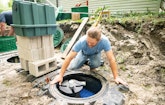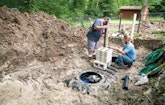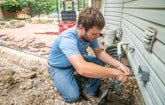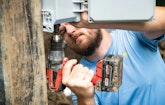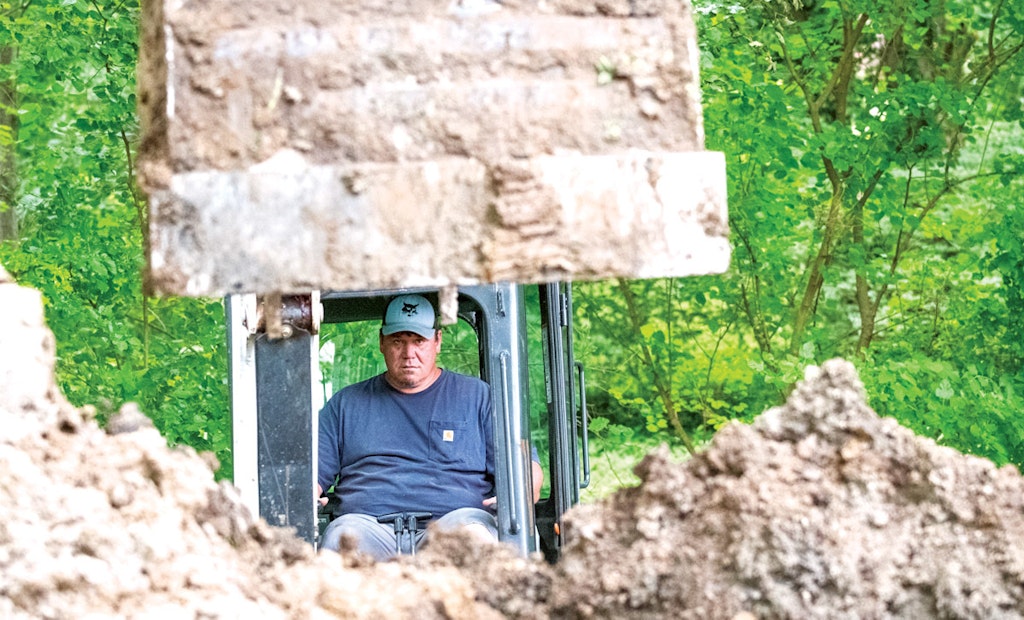
Technician Steve Maxvill concentrates on digging a trench during a septic installation. (Photos by Brad Leeb)
Family company Smith Septic has been pumping septic tanks in central Illinois for decades. Now, with the third generation taking over, the company has expanded into a part of the wastewater business that it had previously ignored: installing.
Smith Septic started installing onsite systems only six years ago.
“It was a natural fit,” says company owner Mark Smith. “For all those years of pumping through three generations, we were giving away all of the installation business. I recall telling Collin when he was about 16 that he might as well get his install license right now. Instead of giving away all the money, we decided to do it ourselves.”
Collin, now 28, is his son and represents the third generation at the company located in Rochester, a small village just east of Springfield, the state capitol.
Many of the onsite systems in their area are 40 or 50 years old and need replacing, Collin says. Many of the subdivisions were developed in the 1980s and ’90s when builders installed aerated systems that discharged into common collectors. Residents believed their systems didn’t need maintenance, and no one was tasked with caring for them, he says.
Collin joined the company full time in 2016. Before that he was working on a career as a chef. It is a passion, but the area where he lives does not provide much opportunity for a career in food.
He also enjoys installing. “I like creating and making the Earth a better place,” he adds.
MOVING THE DIRT
Smith Septic has become very busy after adding installing to its menu of services, Mark says. “With a three-generation, family-owned business, our name’s out there.”
The business was founded by Gene Smith in 1963. He died in 2013. Without his backbreaking dedication to growing the business, say Mark and Collin, they wouldn’t be where they are now, and they wish he could see what has become of what he began.
Even after only six years of installing, the split in business is about 45% installing (with 10-15% of that in new construction), 40% pumping and 5% repairs of lift stations and other smaller jobs, Collin says.
Springfield, known as the home of Abraham Lincoln, has about 114,000 residents, and as in other parts of the country, Mark says, people want to move out of cities and live in the country. They’re willing to pay the price for land and onsite wastewater systems.
About 80% of the company’s installation work is in Sangamon and Menard counties. Sangamon County includes the city of Springfield and handles permitting for neighboring Menard County.
New construction is easier work because there’s plenty of room to site a system and stage equipment, and no worries about damaging existing landscaping, Collin says.
PUMPING AND DUMPING
Septage disposal is relatively simple. Most pumping work is in Sangamon County, so most septage goes to the Sangamon County Water Reclamation District. There are three other places in the company’s territory — in Christian, Morgan and Macon counties — where Smith technicians can dump based on their daily routes. Residential pumping is within about a 30-mile radius of the shop, but the company has some commercial clients that are farther away.
Work goes on year-round because central Illinois is temperate enough for winter installing. When there’s a dry winter week and the soil is not too wet, they’ll put a system in, Collin says.
“We’ve worked when it was zero degrees out putting in a tank. We had to because the tank caved in,” he says.
Another service is system maintenance for several RV parks, both pumping septage and hauling septage to seed package plants with microbes when they’re started in preparation for the summer tourist season, which brings visitors to Lincoln sites.
MACHINE DIVERSIFICATION
Because of all the services it offers, the company uses a variety of equipment.
For pipe work there is a Honda jetter from Imperial Industries, an Amazing Machinery camera and a RIDGID Scout locator.
For pumping, technicians use a 2020 International HV607 from Imperial carrying a 4,000-gallon aluminum tank and a NVE607 pump from National Vacuum Equipment.
A Chevrolet Kodiak 4500 4x4 service truck pulls equipment to jobs. The Smiths are looking for a new equipment transport trailer.
A 2016 Dodge Ram 2500 diesel 4x4 truck and a Mercedes Sprinter van are used for service work.
Installations are handled with a 2014 Bobcat E45 mini-excavator and a 2020 Bobcat T64R skid-steer. A forklift attachment for the Bobcat skid-steer allows the crew to move tanks around, and because this is the Midwest, there’s a snowplow attachment, too.
In addition to Collin and Mark, the other members of the Smith Septic team are Steve Maxvill and Dylan Link.
RETROFIT SOLUTIONS
Many systems the team installs require a lift station because of high water tables or because the effluent pipe emerging from the house is too deep, Collin says. They often pair aerated systems with Infiltrator chambers because the combination allows for smaller drainfields.
“We do a lot of systems where the tank is still good but the laterals have failed,” he says. So they’ll install a lift station and pump up to either new laterals or a sand bed.
They also do traditional gravity septic systems, but the number of those has been on the decline because soils won’t accommodate them.
Smith Septic recently became a BioMicrobics dealer and has its first system with that technology scheduled to go in the ground. Most installations are residential, Collin says. That’s another reason for offering BioMicrobics, he says, because it can handle waste from large, newer houses without covering most of a lot with a drainfield.
Sometimes the company’s challenge isn’t equipment or soil, but people. One recent project occurred at a property that had been subdivided. A house and barn occupied the original parcel, but when the land was subdivided about 1980, one person bought the barn while another took the house.
The house came with an easement for an onsite system to serve the barn property. When that easement was exercised recently, the house owner was unhappy. He wouldn’t allow Smith technicians to cross his land, so the crew had to work from the barn property and entirely within the restrictive drainfield area.
“The entire septic system area was about 20 feet wide by about 30 feet long,” Collin says. “We barely could make it work.”
TOUCHY SITUATION
Technicians first installed half the laterals and had those inspected. Then they backed up and installed an aerated treatment unit. Then they backed up again and installed the other half of the laterals, Collin says.
“The homeowner called the cops on us probably 20 times,” he says. The complaint was always for trespassing. Collin installed fencing around the onsite area, with deputies and the homeowner watching, to ensure no one crossed out of the drainfield zone.
One day the crew hit a privately installed waterline running to the house of the complaining owner. The line was not marked on any set of plans, Collin says.
“Nobody had any idea how to shut it off, so it ran for like a day straight because the small town couldn’t get out to turn it off. They had to dig up the street and cap it,” he says.
While the water was running, it filled the hole for the tank to a depth of about 5 feet. “And it was 5 degrees outside, so the next day it froze rock solid,” Collin adds. “For putting in a system that was only a one-bedroom … something that should take one day, instead took about four or five days.”
The homeowner feared the new system would fail and untreated wastewater would saturate his property, Collin explains. What the homeowner didn’t understand is the reduction in drainfield size possible with an aerated unit. For an advanced treatment unit, Illinois allows drainfields to be two-thirds the size of the field for a septic tank, Mark says.
ALWAYS SOLID SERVICE
The Smiths don’t do much marketing because the company’s reputation brings business to them. They have a company website, and every once in a while they use a Facebook ad or create a post, Collin says.
“We got rid of all of the phone book stuff because that was a waste of time,” he says.
“And money,” Mark adds.
Many plumbing companies in the area refer customers to Smith Septic, Collin says, including one that gave up pumping and installing to concentrate only on plumbing. Three generations of presence generates useful relationships like that, Mark says.
“Good quality, ethical customer service has been our bedrock,” Mark says. “You don’t stick around for three generations if you’re doing something wrong.”
Collin was a perfect fit for installation work, he says, and from there the company grew that business division. In the first year, the team did only two installations, Collin says. In the second year there were eight, then 14, then 28. The trend in 2020 and 2021 has been no different.
“Last year I think we did almost 50,” he says. And that was a year with a very wet spring that stalled work for about four months. During the fall and winter they made up for delays with two or four jobs a week, he says, a pace that stretched the crew very thin.
When they can find spare time, Collin enjoys cooking. Mark is a bicycle enthusiast, especially vintage BMX racing bikes, an interest recovered from his childhood. Both of them like classic cars, and Collin has a 1964 Mercedes he’s restoring.
His Mercedes is almost as old as the family company. And like a solid, reliable car, Smith Septic is still on the road, taking care of its customers as it always has.

